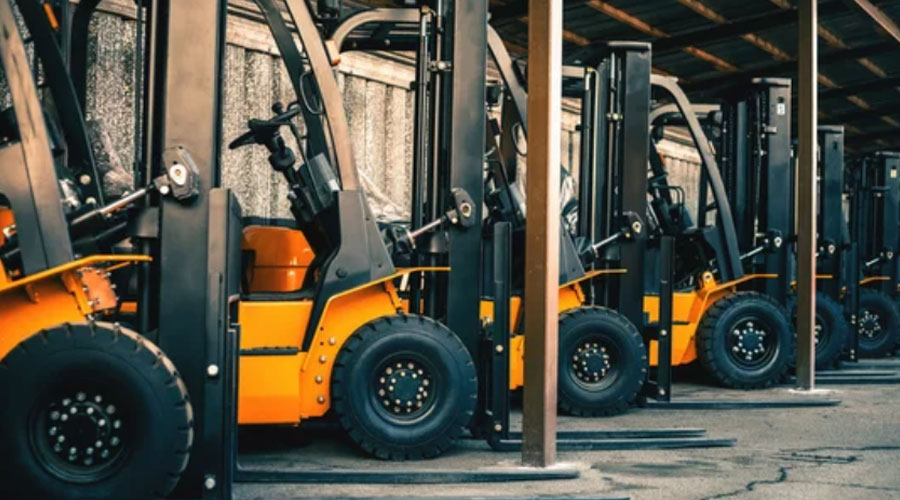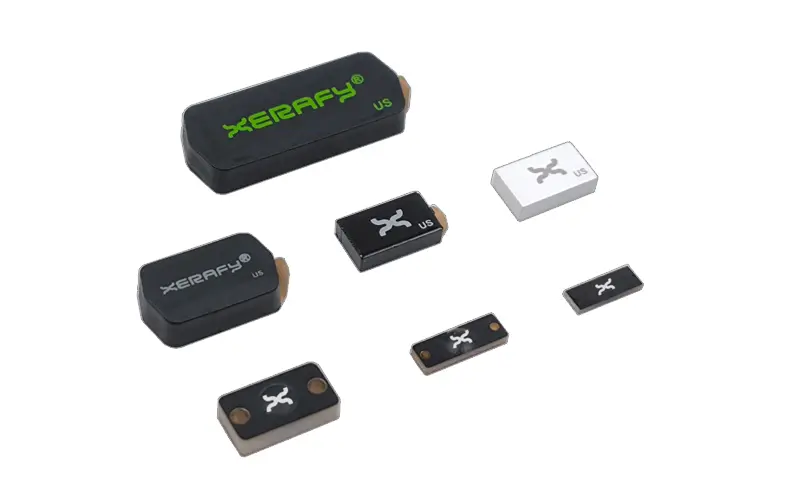RFID Tool Tracking
RFID technology is revolutionizing the way tools and equipment are tracked and managed. By embedding RFID tags into tools, manufacturers can monitor their usage, location, and maintenance needs in real-time, significantly improving operational efficiency.
Why Organizations are Using RFID for Tracking Tools
Keeping track of tools is critical to productivity for manufacturers across all industries. Losing, forgetting or tampering with tools can lead to lost time and money
According to the ISA, manufacturers lose 5% to 20% of productivity due to downtime caused by lost or missing tools and equipment.
RFID tags track tools best because users can scan them from a distance without line of sight. These tags store data about each tool’s history, including who purchased it and who’s using it. They are also commonly used in retail to keep track of inventory throughout supply chains to ensure items are in stock. Teams looking to improve tool and equipment usage will benefit from an RFID tool tracking system.
Adoption Rate
The global adoption rate of RFID technology for asset tracking, including tools and equipment, is increasing by approximately 15-20% annually.
(Source: IDTechEx)
Accuracy Improvement
Implementing RFID can improve inventory accuracy to up to 99%, compared to traditional barcode systems which often result in around 60-70% accuracy.
(Source: Honeywell)
Reduction in Tool Losses
Companies using RFID to track tools report a 20-30% reduction in losses, translating into significant cost savings.
(Source: Deloitte)
Tool inventory management is an essential part of any successful business. It helps ensure that your team has access to the necessary equipment they need to complete their work efficiently. It can also prevent costly mistakes that may result in lost or misplaced tools.
But, it can be difficult to implement this process properly. Manual tracking systems can be error prone and some modern applications can be cost prohibitive. Many businesses fail to find a satisfactory solution, leading to costly lapses and unsafe conditions. In addition to this, it can lead to missed production deadlines and reduced customer satisfaction.
In most cases, the problems stem from manual tool inventory management, relying on foam organizers, sign-in/sign-out procedures, visual IDs, or barcodes. It can be time-consuming to record and locate tools, causing employees to waste a significant amount of time searching for them. Aside from these issue, ineffective procedures can also create an environment where employees are more likely to misplace or lose tools. The process of searching for tools can also be stressful, preventing technicians from completing their jobs as quickly as possible.
Luckily, there is an easy and cost-effective solution to these issues. With an RFID tool tracking solution, your employees will be able to locate tools within seconds and easily log them when they are checked out or returned.
How Does RFID Work in Tool Tracking?
In a typical tool tracking system, each tool is equipped with an RFID tag containing a microchip and antenna. These tags can be either passive, active, or semi-passive. Because they lack a power source, passive tags rely on RFID readers to transmit data, making them a cost-effective option for many applications.
Active tags come with their own power source and transmit data over longer distances, This is why active tags are ideal for tracking larger equipment or tools in expansive areas.
RFID Hardware
Organizations install RFID readers at key points like storage areas, workstations, and facility entrances. When a tagged tool passes by a reader, it automatically logs the tool’s movement, capturing data such as its location, time, and user information. The system transmits this data to a central database, providing instant access to each tool’s status and location.
AN RFID system minimizes the risk of tool loss, misplacement, or theft. If a tool leaves a designated area, the system triggers an alert and shows its location immediately..
Integration Capabilities
Beyond just tracking location, Organizations can integrate RFID systems with inventory management software to monitor the usage and maintenance schedules of tools. This ensures that tools are not only tracked but also maintained regularly, reducing downtime due to equipment failure.
Additionally, RFID can streamline tool check-in/check-out processes, reducing manual labor and errors associated with traditional tracking methods such as barcodes or manual logs.
By automating these processes, organizations can achieve higher operational efficiency, reduce costs related to tool loss or mismanagement, and ensure that the right tools are always available when needed.
What Type of Tools Can You Track With RFID?
RFID tracking is particularly well-suited for a variety of tools commonly used in warehouses and manufacturing facilities. The following types of tools benefit significantly from RFID tracking due to their usage patterns, value, and the critical role they play in operations:
- 5Forklifts
- 5Pallets and pallet trucks
- 5Drum handling equipment
- 5Industrial ladders
- 5Hydraulic stackers
- 5Reusable bins
- 5Carts and dollies
- 5Dock equipment
Other types of tools—such as hand tools, power tools, specialized equipment, large attachments, safety gear, reusable containers, and maintenance devices—are ideal for RFID tracking because they are frequently used, valuable, and often shared across teams in dynamic environments like warehouses and manufacturing facilities. Their portability and the critical role they play in operations make them prone to misplacement, loss, or theft, which can lead to significant downtime and increased costs.
RFID technology provides real-time visibility, ensuring that these tools are always available, properly maintained, and efficiently managed, thereby enhancing operational efficiency and reducing unnecessary expenses.
RFID Tool Tracking Use Cases
RFID provides real-time visibility into tool locations, ensuring equipment is available when needed and reducing workflow delays. By tagging each tool, manufacturers can track usage, monitor movements, and pinpoint bottlenecks using strategically placed RFID readers.
Here are four main use cases for RFID tool tracking in manufacturing:
Compliance and Traceability
In regulated industries, such as aerospace or medical manufacturing, maintaining compliance with stringent quality and safety standards is paramount. RFID-based tool tracking provides an auditable record of tool usage, calibration, and maintenance, facilitating compliance with industry regulations and standards.
Preventing Loss and Theft
RFID technology allows for the implementation of alerts and alarms in cases where tools are moved or leave designated areas without proper authorization. This serves as a powerful deterrent against theft and ensures that tools remain within authorized zones.
Automated Maintenance Scheduling
Technicians can program RFID tags to store each tool’s maintenance history and schedule. The system automatically tracks tool usage and triggers alerts for scheduled maintenance or calibration, ensuring that tools are always in optimal working condition.
Tool Utilization and Optimization
By monitoring the usage patterns of tools through RFID, manufacturers can gain valuable insights into which tools are in high demand and which may be underutilized. This information helps in optimizing tool allocation and ensuring that resources are allocated where they are most needed.

Industries and Scenarios for Tool Tracking
RFID tool tracking can be applied in various industries and scenarios, offering significant benefits in each case. Here are some notable use cases:
Construction Sites
On large construction sites, tools are often moved between different locations, making it easy for them to be misplaced or lost. RFID tags attached to tools allow construction managers to track the location of every tool in real time, ensuring that essential equipment is always available where it’s needed. This reduces delays caused by missing tools and decreases costs associated with purchasing replacements.
Manufacturing Facilities
In manufacturing plants, tools and equipment are essential for maintaining production lines. RFID can be used to track tools to ensure they are returned to their proper storage locations after use, which minimizes downtime due to misplaced tools. Additionally, RFID can be integrated with maintenance schedules, triggering alerts when tools are due for calibration or servicing, ensuring they are always in optimal condition.
Warehouses and Distribution Centers
In warehouses, RFID can track the movement of tools and equipment such as forklifts, conveyor belts, and handheld scanners. This ensures that these assets are readily available for tasks like loading and unloading, inventory management, and order processing. By tracking tool usage and location, warehouses can optimize their workflow, reduce search times, and improve overall productivity.
Healthcare Facilities
Hospitals and medical facilities use a wide range of specialized tools and devices for patient care. RFID can track the location and status of these tools, ensuring they are available and properly sterilized for use. This reduces the risk of delays in treatment due to missing or unavailable equipment and helps maintain strict hygiene standards.
Utility Companies
Utility companies that manage extensive networks (e.g., electricity, gas, water) often require field workers to use a variety of tools for maintenance and repairs. RFID allows these companies to track tool usage in the field, ensuring that workers have the necessary equipment and that tools are returned after each job. This helps reduce losses and improves accountability among workers.
These use cases demonstrate the versatility of RFID technology in improving tool management, enhancing operational efficiency, and reducing costs across various industries.
Tool Usage Optimization and Replenishment
Two of the main advantages to using RFID with tools and equipment is to maximize their usage, and to automate replenishment when items have reached the end of their lifecycle. With RFID’s abilities in tracking, an organizations’ raised visibility allows organizations to streamline tool management, reducing the time spent searching for tools, minimizing losses, and ensuring that tools are readily available when needed.
RFID systems can automate the inventory management process, providing real-time data on tool usage. When a tool is checked out, the system records the user, the time, and the expected return time. If the tool is not returned on time, the system can trigger an alert, helping to prevent loss or misplacement. This also allows for better scheduling and allocation of tools, ensuring that high-demand items are available when needed and reducing downtime due to tool shortages.
For Inventory Replenishment
For replenishment, RFID can automate the reordering process by tracking inventory levels in real-time. When the system detects that a tool’s inventory is below a predefined threshold, it can automatically generate a replenishment order, ensuring that stock levels are maintained without manual intervention. This minimizes stockout risk, prevents operational delays, and helps optimize inventory levels, reducing the costs associated with overstocking or emergency ordering.
Building an RFID Tool Tracking System
To set up a successful RFID tracking system for tools and equipment, you’ll need several key hardware components. First, RFID tags come in two types: passive tags, which are activated by the reader’s signal and are ideal for general tools, and active tags, which have their own battery for frequent updates, suitable for high-value items.
You can install fixed RFID readers at strategic points for continuous monitoring or use handheld ones for spot-checks. Antennae enhance the signal range of these readers. An RFID printer or encoder may be used for creating customized tags. Select RFID-enabled labels and tags based on environmental conditions to ensure durability.
Working with Middleware
You can use middleware or edge devices to process RFID data before it reaches the central system. A strong network infrastructure is needed to connect the readers to the central management software, which handles the tracking data. Power supply considerations, including backups, are also important for ensuring uninterrupted operation.

RFID Hardware
To set up a successful RFID tracking system for tools and equipment, you’ll need several key hardware components. First, RFID tags come in two types: passive tags, which are activated by the reader’s signal and are ideal for general tools, and active tags, which have their own battery for frequent updates, suitable for high-value items.
RFID readers can be either fixed, positioned at strategic points for continuous monitoring, or handheld for spot-checking. Antennae enhance the signal range of these readers. You can use an RFID printer or encoder to create customized tags. Additionally, RFID-enabled labels and tags should be selected based on the environment, ensuring durability.
Hardware Options
- RFID Tags: Passive (battery-free) and active (battery-powered) options.
- RFID Readers: Fixed (stationary) and handheld (portable).
- Antennae: Amplifies RFID signal range.
- RFID Printer/Encoder: For creating custom RFID tags (optional).
- RFID-enabled Labels/Tags: Durable and environment-specific.
- Middleware/Edge Devices: Filters and processes RFID data (optional).
- Network Infrastructure: Ensures communication between hardware.
- Power Supply: Adequate and backup power for all components.
RFID Software
For a successful RFID tracking system that monitors tools and equipment, the software must have several key capabilities. It should enable real-time tracking and inventory management, allowing for instant updates on tool locations and statuses. Integration with other enterprise systems like ERP and asset management is crucial for a unified view. The software should offer data analytics and reporting features to provide insights into usage patterns and maintenance needs, along with predictive analytics for future planning.
The software provides customizable alerts and notifications to ensure timely responses to specific events, while role-based access control secures the system. It should also manage RFID tags effectively, maintain historical data for audits, and offer mobile or remote access. The software must be scalable, flexible, and capable of integrating with middleware for real-time data processing.
Additionally, it should track maintenance schedules and lifecycle stages, ensuring timely servicing and replacements. Lastly, compliance and security features are essential to protect data and meet industry standards.
Software Capabilities
- Real-Time Tracking: Instantly updates tool and equipment locations.
- Inventory Management: Automatic check-in/check-out and status updates.
- Data Integration: Integrates with ERP and other enterprise systems.
- Analytics and Reporting: Provides insights and predictive analytics.
- Alerts and Notifications: Customizable alerts for specific events.
- User Access Control: Role-based access to secure the system.
- Asset Tag Management: Manage and update RFID tags.
- Historical Data: Logs all movements for audit trails.
- Mobile/Remote Access: Access the system from anywhere.
- Scalability: Handles growing asset numbers and changing needs.
- Middleware Integration: Supports real-time data processing.
- Maintenance Tracking: Manages maintenance schedules and lifecycle stages.
- Security and Compliance: Protects data and ensures regulatory compliance.
How Organizations Can Get Started with RFID
Organizations can begin implementing RFID for tool tracking by first assessing their specific needs and objectives, identifying pain points such as tool loss or inventory inaccuracies.
After defining their goals, organizations should select RFID tags and readers based on tool materials and the work environment.. Starting with a pilot project is crucial to test the system on a smaller scale, allowing for adjustments before full-scale implementation.
A successful rollout requires planning infrastructure, placing RFID readers strategically, and integrating the system with existing inventory tools.
Interested in RFID?
An RFID tracking system can help organizations of all sizes improve their supply chain efficiency. Contact the CYBRA team to schedule a demo today.















 RFID Cage
RFID Cage
